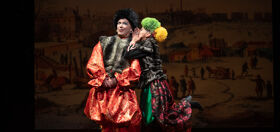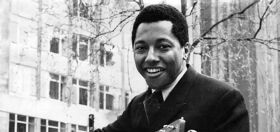
Dumping the contents, word for word, of some five million books into a massive searchable database, Google has unleashed something that’s akin to Google Trends — for the historical written word. All five hundred billion of them. The search giant’s Books Ngram Viewer lets you see how often certain words appeared over the course of history. Naturally, we wanted to check up on the fags.

As you can see, authors were mentioning “homosexuals” almost not at all as recently as the 1800s, but usage began to take off around 1900. Meanwhile, “gay” was likely used for its original purpose: to mean “happy,” which is why it enjoys historical prominence. That is until the 1980s, when that spike is due to (I can only guess) the LGBT movement gaining visibility, and more being written about us. (This is just my loose theory.)

We see a somewhat similar trend in “lesbian” vs. “dyke,” although the latter word, while used with some regularity, never took off the way “lesbian” did. Again, that word starts soaring in the 80s.

And then there’s “fag,” “faggot,” and “queer.” The first two register in small numbers, especially next to “queer” — a word that, like “gay,” was likely used in place of words like “weird” and “different.” I’m not sure how to explain the sudden drop beginning in the 1930s. Can you?
How about we take this to the next level?
Our newsletter is like a refreshing cocktail (or mocktail) of LGBTQ+ entertainment and pop culture, served up with a side of eye-candy.
Here’s more about Google’s project, which includes a note that the data is normalized/weighted to account for the increase in the number of books published per year as time moved forward.


















Sam
I’d guess that the drop in usage of “queer” happened as its meaning shifted and it became derogatory and thus not publishable. It makes sense that the usage would shrink as it became seen as more and more offensive and unmentionable until the 80’s when it was reappropriated.
Tom
‘queer’ should have been left ‘un-appropriated’
I am gay a man. Not “weird” or “different.” I am me.
That Bitch Téa Delgado
I much prefer “queer” to “gay” – I’m not always happy, but I’ve always been different.
By the way, there’s a good reason authors weren’t mentioning “homosexuals” until around 1900 – the word didn’t exist until the 1870s.
Riker
@Tom: we *are* different, though. We deserve the same rights as anyone else, but we don’t have to emulate them. Gays are different from breeders. Our culture is entirely different.
ewe
I was told by a gay man in his eighties during the 1980s that he had never ever heard the word gay until the late SF chronicle columnist Herb Caen had coined the word in his weekly ramblings. I was very surprised. So i believe that to be true as far as the san francisco area is concerned.
ewe
@Riker: I hate that word “breeders”. It is so distasteful. I have never met a gay person that i liked that used that word. It is the height of insecurity and it is also self damaging. There are plenty of gay parents who have kids the old fashioned way too.
ewe
@Riker: I agree with you that we should never ever try to imitate straight people. It would be such a waste of a good life.
Jeb
That’s a very interesting post. Too bad queer meant something totally different way back when and the same for gay.
ewe
@Jeb: I have a very hard time thinking of myself as queer because that word was engrained in my brain as “strange” and i still do not want to be associated with it even though i understand and accept that it has lost its negative connotaions in the gay community. But dare i say ONLY in the gay community i think.
Kev C
It looks like the nazis distracted people from queers, disproving General Amos’ theory.
P.
Wild how “queer” spiked in the Roaring 20s. Maybe that was the peak of jazz babies using is as slang for “wildly fond for”.
And I quote:
Show her where to park her girdle
Oh, her mother’s blood is curdle
If she’d hear
Her baby’s queer
For All That Jazz
DR
@Riker:
What culture? You act as though there is some great big culture we all agree on and are a part of. We’re not and there isn’t. The only thing which separates me from a straight guy is who I love, that’s it. I don’t need to wear my sexual orientation on my sleeve and be “DR the queer”. There’s more to me than that.
Yes, I am an assimilationist and damn proud of it.
Jim Hlavac
Oh the little known history of “Gay” and “homosexual.”
The big word was created by a German sociologist, Kraft-Ebbing, in a paper published in German in 1898. By 1920 the word had entered English. He also coined “heterosexual” in the same paper. Which was a study on “onanists.” Which was a word used during the 1800s for gay people because in the Bible Onan spills his seed and does not have children.
The word “gay” on the other hand, was brought into English by Eleanor of Aquitaine, when she married Henry II of English in 1150, after she had divorced Louis VII of France. She was ten years older than Henry. But she gave him eight kids (five sons, three daughters. She also had two daughters with Louis.) Of those five sons three died in early adulthood. One was Richard II, the Lionhearted. Of Robinhood fame, and tights, of course. His brother was Prince John. Throughout his time as King, Richard did not get married. His mother, Eleanor, wrote letters to him — a lot. There’s lot of them around. And chronicles by other people too, about the “gai” King Richard.
For in Provence, the language of Aquitaine, which was a dialect of Old French, the word for, um, us gay folks, was “gai” With a little double dot over the “i”, and umlaut. Her letters, most of which are in Latin, and some in Provence, use “gai” in talking to and about her favorite son Richard.
In 1185 Richard was camped out in Sicily, with his Italian boyfriend. He was, he said, waiting for fair weather to sail to take Jerusalem from the Muslims in the Crusades. He had dallied there in Sicily for six months without fair winds, he said. And finally his mother bolted from England, and crossed Europe as quickly as a Medieval queen could travel, and stopped to talk to the pope about the problem, and got to Sicily and said “Stop with the boyfriend, go to Jerusalem, and get married.” It’s recorded that he said, “But Momma, I’m gay.” It’s recorded she said “OK, keep the boyfriend, but get married.”
He went, didn’t get to the Holy Land, went back to England, was arrested by Henry of Germany, who held him in Trifels Castle, until Eleanor came up with 200,000 gold and silver pieces to ransom her gay son. Prince John, as all of us who know Robinhood, was busy messing with England and itching to be king, so he tried to nab all the taxes before it could be used to ransom his brother. “That gai brother of mine should not be king,” he said.
Finally out, Richard was in France, besieging town and castle. A 16 year old archer was said to have shot Richard through the eye. It was recorded by the Chroniclers, that “the little bugger got him.” And when the English took the city they flayed the boy alive, and slaughtered most of the rest for killing “Our gay king.” It was known, it was talked about, it was a political issue of the times. Richard was “gai” indeed.
Richard is buried next to his mother Eleanor in a monastery in France, the only English king not buried in England. He was a momma’s boy.
John became King, and was a spendthrift, licentious, mean, capricious, wastrel, rapacious womanizer. Other than that he was a pee-poor king. For 25 years he was on the throne and bullied the barons. Until the dragged his sorry ass to Runnymede and made him sign Magna Carta, which stripped Absolute power from the king. In the process, many a baron bemoaned in their letters and chronicles that they missed “good old gay king Richard.” John was so bad, in fact, in so many ways, that there’s never been a “King John II” In fact, no member of the British royal family has the name John, though John is the most popular name of the realm.
In the meantime, there was an Old Saxon word “gay” for happy. And over time “gai” and “gay” were written the same, and the two conflated.
Kev C
@Jim Hlavac: Onanists are wankers, jerk-offs, not homosexuals. The bible term commonly used in Europe for homosexuals was Sodomites, who were punished by jail, flogging or burning at the stake. According to Google’s Ngram, the term has become popular again.
Jim Hlavac
And let’s look at another famous use of the word “gay” for gay, from history. It’s well recorded.
I love the story of King James, of Bible writing fame. The Good Book thrown at us was compiled into an “official” English version by the very gay King James. The most famous quip of 1603 was “We have had King Elizabeth, and now we shall have Queen James.” Broadsheets and cartoons still exist which have this quip. James beheaded a few of the quipsters for their indecency. Everyone knew he was “gay.” They used the word to say it. And Elizabeth I was worried about Mary, Queen of Scots’ strong claim to the English throne, especially since her dad Henry VIII legally declared Elizabeth a bastard, and never rescinded it. It was her sister Mary “Bloody” Tudor who rescinded the edict of bastard.
Mary of Scotland had been married off to Francis of France, but he died at about 23 years old, so she went back to Scotland. And Elizabeth concocted her plan — “Send Lord Darnley, that fairy and gay man, to my cousin Mary, so naught might come of it.” The scribes keeping records wrote it like that; fairy and gay. For Darnley was very openly gay, and very good looking it’s said. So he did as commanded. He married Mary. Did his duty, and James was born. Shortly thereafter the Scottish Lords blew up his pleasure palace below Holyrood in Edinburgh, but Darnley didn’t die. So they dragged him out of the rubble and stabbed him to death. A little gay bashing of the times. Which they wrote about — “We’ve killed that gay Darnley.” They were proud of what they did.
Mary was beheaded by Elizabeth in 1585. Poor James was brought up to hate both his mother and his father. When Elizabeth died, James was the only one around with a claim to the throne. So in the Act of Union between Scotland and England, James VI of Scotland (which he was) was made into James I of England. The man was brilliant, and lived with Robert, his Lord Chamberlain. (The keeper of the royal bedroom) And James’s ministers, spiritual and temporal, made him visit his wife once a month whether he wanted to or not. And he did have a son. The obnoxious and very randy heterosexual Charles I. Poor Charlie, lost his head too, to Cromwell.
James did though, have his mother exhumed and brought to Westminster in London, where she lies today, not far from Elizabeth. Not long after he finished chairing the committee which compiled the Bible with his name on it.
Most of this is in the well researched Antonia Frasier biography of Mary. But there’s plenty of other sources. Dry, dusty history, for sure. But history none the less.
“Gay” has meant gay for nearly 900 years in English, and these fools against us think we stole it sometime in about 1980 or something. We didn’t steal it, they abandoned its “Happy” use, but that’s not our problem. Yet, how utterly ahistorical. How ludicrous. How unknown. And they want to use some foreign word, “homosexual” — which strikes me then, that they’re more into their “agenda” against homos and less into being homo sapiens, or, Thinking Man.
Jim Hlavac
Kev C, correct, Onanists are “wankers.” Tell that to Kraft-Ebbing and the German sociologists who used the term for gay people. I can’t help it what they wrote.
Miss Understood
@DR: Culture is very vague and fluid but it is also very real. It is not like joining a club, we don’t all get together and agree on things. People with certain things in common see the world from a particular perspective which in turn leads to more commonalities. You don’t have to share all of these commonalities to be part of a community. Somewhere in your life there is a way you relate to the world that is, in a subtle way, similar to other gay people. A conversation you would interpret a certain way that is different than the average straight person would. This would overlap with many other factors in your life such as the region you were raised in, your family background, etc. Simply seeking out friendships with a few other gay people is a sign of community.
For example, Americans live in America. We are all part of the American community. While two individuals with very different lives in America may seemingly have nothing in common they are still part of the American community. Looking at Americans as a group you can draw up statistics which differentiate them from people in India.
White Americans don’t all share the same religion, political beliefs, taste in music, food, etc. Yet if you look at them as a group, statistically, there is definitely a difference in religion, political beliefs, music, food, etc from Chinese Americans.
Cultural differences between groups are often mistaken for stereotypes. It’s a stereotype if it’s applied to each individual rather than statistically toa group, especially if it’s exaggerated and caricatured.
DR
@Miss Understood:
Then by all means, educate me as to what “gay culture” is. I see the term thrown around far too often with no real definition. So what does it entail? And do it without presuming you know how I would or would not interpret conversations, images, etc. You don’t.
The example you gave, the “American community”, is what I would define as the “American population”, and I see the GLBTs the same way. I don’t see us as a “community” as much as I see us as a “population” based simply on this notion of “not heterosexual”. That’s not enough to suggest “community” to me.
Kev C
@Jim Hlavac: Kraft-Ebbing obviously wasn’t hip to the new lingo.
Biff
@Jim Hlavac: Jim – that was wonderfully entertaining and packed with historical info. Well done, chap! My heart is young and gai once again.
eagledancer
For further clarification– It has been pointed out that Kraft-Ebbing was responsible for the neologic “homosexual” although it was obviously in German. It didn’t get translated into English and used until the 1900s, but the word “heterosexual” did not have its current meaning until 1932 (according to the dictionaries). Its original clinical meaning was what we would now call a sex-addict or nymphomaniac.
Ko
Well I’m not entirely sure if this has been mentioned or not, but the terms “heterosexual” and “homosexual” weren’t even coined until 1892. I feel as if the years in the first graph shouldn’t even start until maybe a decade or two before then, considering “homosexual” didn’t even exist then.